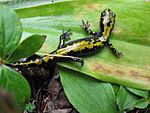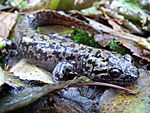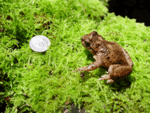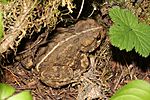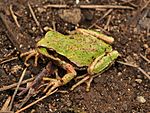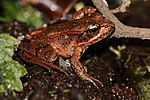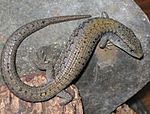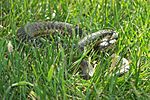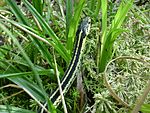Amphibians and reptiles of Mount Rainier National Park facts for kids
Mount Rainier National Park is home to many amazing creatures! You can find 14 different kinds of amphibians and 5 types of reptiles living here. These animals play important roles in the park's ecosystems.
Amphibians: Frogs, Toads, and Salamanders
Amphibians are cool animals that can live both in water and on land. They usually start their lives in water, like tadpoles, and then grow up to live more on land.
Newts: The Rough-skinned Newt
- Rough-skinned Newt (Taricha granulosa)
- This newt is famous for its strong poison! It lives along the West Coast of the United States and in British Columbia.
- You can find them from Alaska all the way down to California. They are not common east of the Cascade Mountains.
Mole Salamanders: Hidden Wonders
- Northwestern Salamander (Ambystoma gracile)
- These are pretty big salamanders, growing up to 8.7 inches long!
- They live along the Pacific coast of North America, from Alaska to California.
- You can find them from sea level up to the tree line in mountains.
- Long-toed Salamander (Ambystoma macrodactylum)
- This salamander is super adaptable! It lives in many different places.
- You can find it in rainforests, forests, plains, and even high up in alpine meadows.
- Adults often hide under logs, rocks, or in small animal burrows.
- In spring, they gather near rivers, streams, lakes, and ponds to breed.
Pacific Giant Salamanders: Big and Bold
- Coastal Giant Salamander (Dicamptodon tenebrosus)
- This large salamander lives in temperate forests, rivers, lakes, and marshes.
- It is found only in the Pacific Northwest: California, Oregon, Washington, and southern British Columbia.
- Cope's Giant Salamander (Dicamptodon copei)
- This salamander also lives only in the Pacific Northwest, specifically on the Olympic Peninsula in Washington.
- Its natural homes are temperate forests, rivers, lakes, and marshes.
- Sadly, its habitat is shrinking due to human development.
Lungless Salamanders: Breathing Through Skin
- Ensatina (Ensatina eschscholtzii)
- This salamander is part of a group that doesn't have lungs! They breathe through their skin.
- You can find them in forests and woodlands from British Columbia down to Mexico.
- Larch Mountain Salamander (Plethodon larselli)
- This salamander lives only in the Cascade Mountains of southern Washington and northern Oregon.
- Its favorite places are temperate forests and rocky areas.
- Van Dyke's Salamander (Plethodon vandykei)
- Like most land salamanders, Van Dyke's Salamander lives near water.
- They hide under rocks, logs, and bark near lakes, rivers, and streams.
- They are found in Washington, northern Idaho, and northwestern Montana, especially in hilly or mountainous areas.
- Western Redback Salamander (Plethodon vehiculum)
- This salamander lives in Canada and the United States.
- Its natural homes are temperate forests and rocky areas.
- It has a stripe on its back that can change color from red to yellow!
Tailed Frogs: Unique Frogs
- Rocky Mountain Tailed Frog (Ascaphus montanus)
- This frog is special because it has a "tail" (which is actually part of its reproductive system).
True Toads: The Western Toad
- Western Toad (Anaxyrus boreas)
- This is a large toad, growing between 2 and 5 inches long.
- It lives across western North America, from British Columbia and Alaska down to Mexico.
- In the Pacific Northwest, you can find them in mountain meadows and forests.
Tree Frogs: The Pacific Tree Frog
- Pacific Tree Frog (Pseudacris regilla)
- This frog lives along the West Coast, from California to British Columbia.
- They live from sea level up to over 10,000 feet in many different habitats.
- They are the only frogs that make the famous "ribbit" sound!
- They can change colors, from green to brown, over hours or weeks.
True Frogs: The Cascades and Northern Red-legged Frogs
- Cascades Frog (Rana cascadae)
- This frog is found mainly in the Cascade Range and Olympic Mountains.
- It was first found in the Cascade Mountains in California.
- You can find them in forests, grasslands, rivers, swamps, and lakes.
- They usually live at elevations between 2,180 and 8,040 feet.
- Northern Red-legged Frog (Rana aurora)
- This frog lives along the coast from British Columbia to Northern California.
- It has smooth skin and a narrow waist.
- This frog needs calm water to breed, like ponds or marshes. It usually stays close to these breeding spots.
- Amphibians of Mount Rainier National Park
Reptiles: Lizards and Snakes
Reptiles are cold-blooded animals that have scales and usually lay eggs.
Lizards: The Northern Alligator Lizard
- Northern Alligator Lizard (Elgaria coerulea)
- This is a medium-sized lizard found along the Pacific Coast and in the Rocky Mountains.
- Its range stretches from British Columbia down to central California.
- You can find it from sea level up to about 11,000 feet high.
- It lives in different types of forests and shrublands.
Boas: The Rubber Boa
- Rubber Boa (Charina bottae)
- This is the most northern type of boa snake!
- It lives across a large part of the western United States, from the Pacific Coast to Montana.
- Rubber Boas live in many different places, like grasslands, meadows, forests, and high mountains.
- They can be found from sea level up to over 10,000 feet.
Garter Snakes: Common Park Snakes
- Northwestern Garter Snake (Thamnophis ordinoides)
- This snake is found only in North America, in Oregon, Washington, California, and British Columbia.
- It is the most common snake you'll find in Mount Rainier National Park!
- These snakes are small, usually 14 to 21 inches long.
- They are often found at the edge of meadows, surrounded by forests.
- Wandering Garter Snake (Thamnophis elegans vagrans)
- This snake is a type of Western Terrestrial Garter Snake.
- It lives in Southwestern Canada and the Western United States.
- Most have a yellow, orange, or white stripe down their back.
- This snake often lives in forests and likes to be near water.
- Valley Garter Snake (Thamnophis sirtalis fitchi)
- This snake is a type of common garter snake.
- It is found in North America.
- Most garter snakes have yellow stripes on a brown background. They are usually 3 to 5 feet long.
- This snake is active during the day. In summer, it's most active in the morning and late afternoon.

All content from Kiddle encyclopedia articles (including the article images and facts) can be freely used under Attribution-ShareAlike license, unless stated otherwise. Cite this article:
Amphibians and reptiles of Mount Rainier National Park Facts for Kids. Kiddle Encyclopedia.



